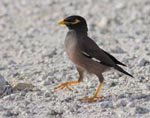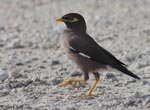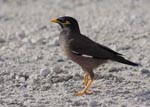| Length: 9.5 inches | Wingspan: 18 inches | Seasonality: Non-resident in South Dakota |
| ID Keys: Yellow bill, yellow legs, yellow around eye, black head, brown body | ||
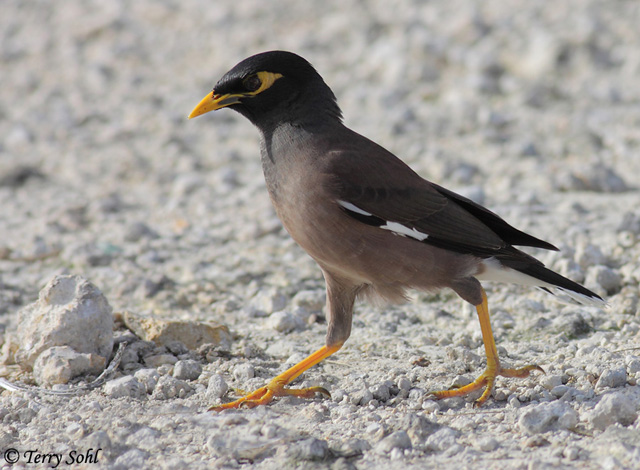 The
Common Myna is a native of southern Asia, but they have been introduced in
many other parts of the world. In North America, they have become
established in southern Florida, where they are successfully reproducing in
the wild and are expanding in range and in numbers. There is concern
about the species as an invasive species, as in other parts of the world,
they have rapidly increased and caused significant damage to agricultural
crops and to natural ecosystems. The IUCN lists the Common Myna as one
of the world's 100 most destructive invasive species, with Australian and
South African ecosystems particularly impacted by the species. In
Australia, they are now likely the most common bird species in many large
urban centers. Given their rapid expansion in Florida, there are
concerns that they could have a very significant impact on North American
ecosystems if they continue to spread.
The
Common Myna is a native of southern Asia, but they have been introduced in
many other parts of the world. In North America, they have become
established in southern Florida, where they are successfully reproducing in
the wild and are expanding in range and in numbers. There is concern
about the species as an invasive species, as in other parts of the world,
they have rapidly increased and caused significant damage to agricultural
crops and to natural ecosystems. The IUCN lists the Common Myna as one
of the world's 100 most destructive invasive species, with Australian and
South African ecosystems particularly impacted by the species. In
Australia, they are now likely the most common bird species in many large
urban centers. Given their rapid expansion in Florida, there are
concerns that they could have a very significant impact on North American
ecosystems if they continue to spread.
Habitat: Found in open woodlands historically, but they have adapted very well to a human presence and are now often found in urban and suburban areas, as well as around agricultural land.
Diet: Omnivorous, feeding on a wide variety of food items. Typical food items include insects, spiders, and other small invertebrates, seeds, nuts, grain, fruits, berries, small vertebrates such as small lizards or rodents, and bird eggs. They will also often feed on human refuse.
Behavior: Most foraging is done by walking along the ground.
Nesting: Common Myna pairs often breed for life. The pair build a nest in a cavity, either a natural tree cavity, or often a cavity in a man-made object. The nest consists of twigs, leaves, moss, and often, human refuse or other odd items. The female usually lays 3 to 5 eggs, and she does most of the incubating of the eggs. When the eggs hatch, both parents help feed the young. The young fledge after about 3 or 4 weeks, but are typically still dependent upon the parents for a few weeks after fledging.
Song: Common Myna have a variety of calls, including screeching, croaking, and whistled calls.
Migration: Considered a permanent resident in their North American range.
Interactive eBird Map: Click here for an interactive eBird map of Common Myna sightings
Similar Species: Distinctive compared to other North American birds, if seen well.
Conservation Status: Populations are increasing in North America, as well as in other parts of the world. They are found over a wide geographic area and are very common in some areas. The IUCN lists the Common Myna as a species of "Least Concern".
Further Information: 1) WhatBird.com - Common Myna
2) ARKIVE.org - Common Myna
3) Animal Diversity Web - Common Myna
Photo Information: Photo taken on December 10th, 2012 - Near Everglades National Park in Florida - Terry Sohl
| Click below for a higher-resolution map |
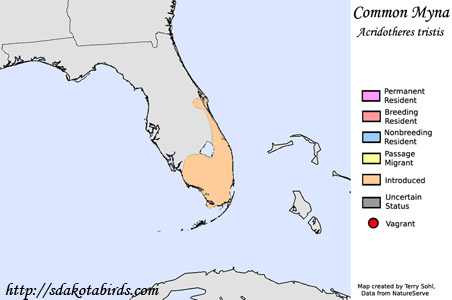 |
| South Dakota Status: Non-resident in South Dakota |
Additional Common Myna Photos
Click for a higher-resolution version of these photos
